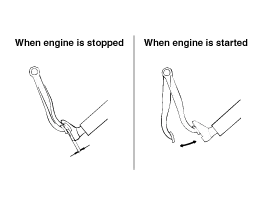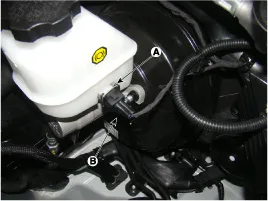Hyundai Genesis (DH): Brake System / Brake Booster Repair procedures
Hyundai Genesis (DH) 2013-2016 Service Manual / Brake System / Brake System / Brake Booster Repair procedures
| Brake Booster Operating Test |
For simply checking the brake booster operation, perform the following tests.
| 1. |
Run the engine for one or two minutes, and then stop
it.Depress the pedal several times, and if the pedal stroke gradually
decreases, the brake booster operates properly. If there is no change,
the booster is faulty.
|
| 2. |
With the engine stopped, step on the brake pedal several times.
Then step on the brake pedal and start the engine. If the
pedal moves downward slightly, the booster is in good condition. If
there is no change, the booster is inoperative.
|
| 3. |
With the engine running, step on the brake pedal and then
stop the engine.Hold the pedal depressed for 30 seconds. If the pedal
height does not change, the booster is in good condition, if the pedal
rises, the booster is inoperative.
If the three tests mentioned above result in good condition, the booster performance can be determined as good.
Even if one of the three tests mentioned above is not in good
condition, check the check valve, vacuum hose and booster for
malfunction.
|
| Removal |
Brake Booster
| 1. |
Turn ignition switch OFF and disconnect the negative (-) battery cable. |
| 2. |
Disconnect the ECM connector (A) and TCM connector (B). IDB (C) and then remove the noise barrier (D).
|
| 3. |
Remove the Cowl Top Cover.
(Refer to Body - "Cowl Top Cover") |
| 4. |
Remove the ECM, TCM & IDB. |
| 5. |
Remove the clamp (A) and brake vacuum hose (B).
|
| 6. |
Remove the clip (A) and then disconnect brake fluid level switch connector (B).
|
| 7. |
Remove the brake fluid from the master cylinder reservoir with a syringe.
|
| 8. |
Loosen the hose connecting bolt(A) and disconnect the brake tube.
|
| 9. |
Remove the master cylinder (B) from the brake booster after loosening the mounting nuts (A).
|
| 10. |
Remove the snap pin (A) and clevis pin (B).
|
| 11. |
Remove the mounting nuts.
|
| 12. |
Remove the brake booster. |
| Inspection |
| 1. |
Inspect the vacuum hose.
|
| 2. |
Check the boot for damage.
|
| Installation |
| 1. |
To install, reverse the removal procedure.
|











